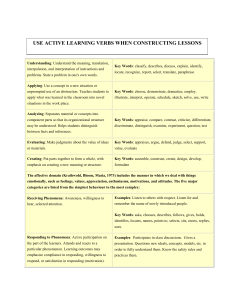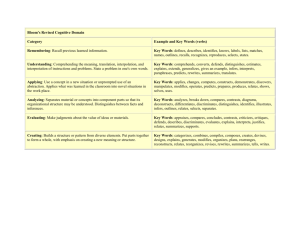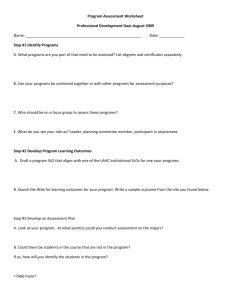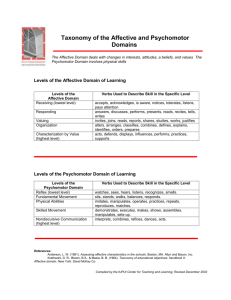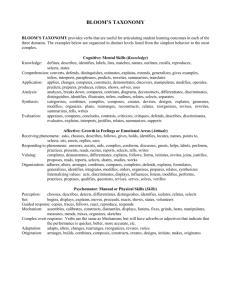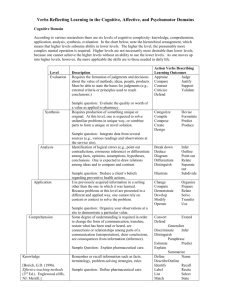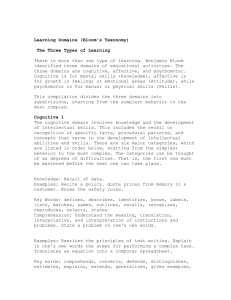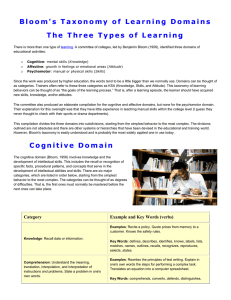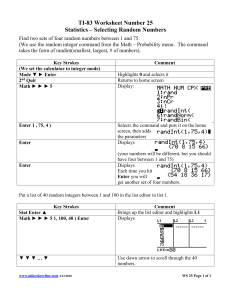Learning Objectives: Affective, Cognitive, Psychomotor Domains
advertisement
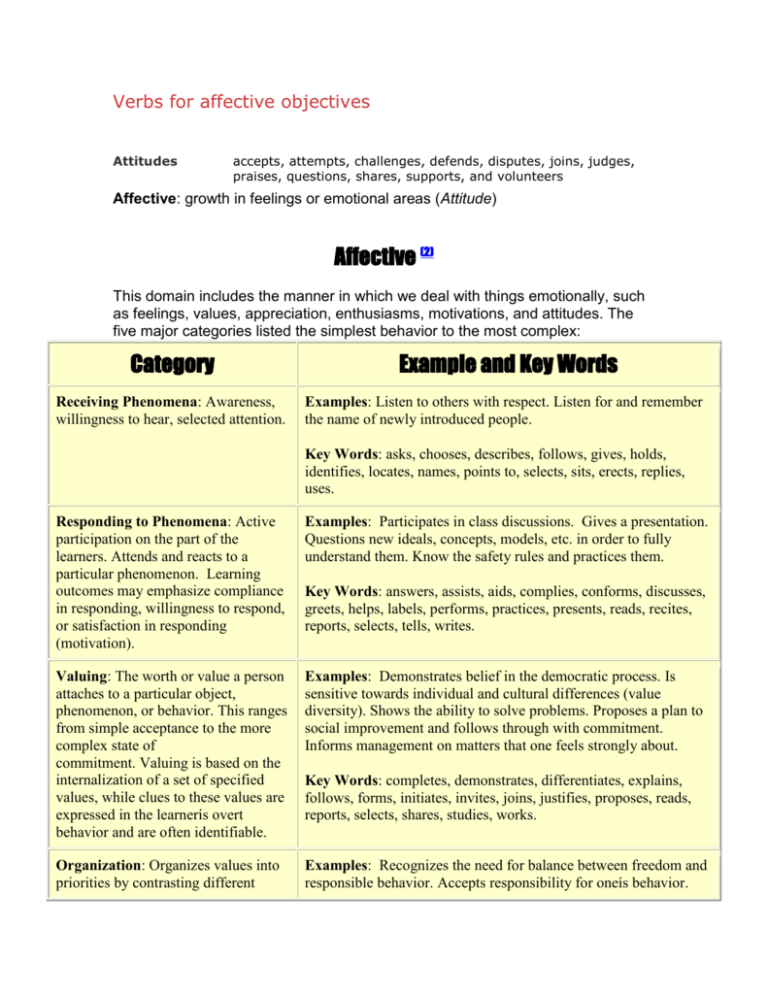
Verbs for affective objectives Attitudes accepts, attempts, challenges, defends, disputes, joins, judges, praises, questions, shares, supports, and volunteers Affective: growth in feelings or emotional areas (Attitude) Affective (2) This domain includes the manner in which we deal with things emotionally, such as feelings, values, appreciation, enthusiasms, motivations, and attitudes. The five major categories listed the simplest behavior to the most complex: Category Receiving Phenomena: Awareness, willingness to hear, selected attention. Example and Key Words Examples: Listen to others with respect. Listen for and remember the name of newly introduced people. Key Words: asks, chooses, describes, follows, gives, holds, identifies, locates, names, points to, selects, sits, erects, replies, uses. Responding to Phenomena: Active participation on the part of the learners. Attends and reacts to a particular phenomenon. Learning outcomes may emphasize compliance in responding, willingness to respond, or satisfaction in responding (motivation). Examples: Participates in class discussions. Gives a presentation. Questions new ideals, concepts, models, etc. in order to fully understand them. Know the safety rules and practices them. Valuing: The worth or value a person attaches to a particular object, phenomenon, or behavior. This ranges from simple acceptance to the more complex state of commitment. Valuing is based on the internalization of a set of specified values, while clues to these values are expressed in the learnerís overt behavior and are often identifiable. Examples: Demonstrates belief in the democratic process. Is sensitive towards individual and cultural differences (value diversity). Shows the ability to solve problems. Proposes a plan to social improvement and follows through with commitment. Informs management on matters that one feels strongly about. Organization: Organizes values into priorities by contrasting different Examples: Recognizes the need for balance between freedom and responsible behavior. Accepts responsibility for oneís behavior. Key Words: answers, assists, aids, complies, conforms, discusses, greets, helps, labels, performs, practices, presents, reads, recites, reports, selects, tells, writes. Key Words: completes, demonstrates, differentiates, explains, follows, forms, initiates, invites, joins, justifies, proposes, reads, reports, selects, shares, studies, works. values, resolving conflicts between them, and creating an unique value system. The emphasis is on comparing, relating, and synthesizing values. Explains the role of systematic planning in solving problems. Accepts professional ethical standards. Creates a life plan in harmony with abilities, interests, and beliefs. Prioritizes time effectively to meet the needs of the organization, family, and self. Key Words: adheres, alters, arranges, combines, compares, completes, defends, explains, formulates, generalizes, identifies, integrates, modifies, orders, organizes, prepares, relates, synthesizes. Internalizing values (characterization): Has a value system that controls their behavior. The behavior is pervasive, consistent, predictable, and most importantly, characteristic of the learner. Instructional objectives are concerned with the student's general patterns of adjustment (personal, social, emotional). Examples: Shows self-reliance when working independently. Cooperates in group activities (displays teamwork). Uses an objective approach in problem solving. Displays a professional commitment to ethical practice on a daily basis. Revises judgments and changes behavior in light of new evidence. Values people for what they are, not how they look. Key Words: acts, discriminates, displays, influences, listens, modifies, performs, practices, proposes, qualifies, questions, revises, serves, solves, verifies. Affective Objective (C) Given the opportunity to work in a team with several people of different ethnic backgrounds, (A) the student (B) will demonstrate a willingness to participate and positive nondiscriminatory interactions with all team members, (D) as measured by a checklist utilized/completed by non-team members. Cognitive (1) The cognitive domain involves knowledge and the development of intellectual skills. This includes the recall or recognition of specific facts, procedural patterns, and concepts that serve in the development of intellectual abilities and skills. There are six major categories, which are listed in order below, starting from the simplest behavior to the most complex. The categories can be thought of as degrees of difficulties. That is, the first one must be mastered before the next one can take place. Category Knowledge: Recall data or information. Example and Key Words Examples: Recite a policy. Quote prices from memory to a customer. Knows the safety rules. Key Words: defines, describes, identifies, knows, labels, lists, matches, names, outlines, recalls, recognizes, reproduces, selects, states. Comprehension: Understand the meaning, translation, interpolation, and interpretation of instructions and problems. State a problem in one's own words. Examples: Rewrites the principles of test writing. Explain in oneís own words the steps for performing a complex task. Translates an equation into a computer spreadsheet. Application: Use a concept in a new situation or unprompted use of an abstraction. Applies what was learned in the classroom into novel situations in the work place. Examples: Use a manual to calculate an employeeís vacation time. Apply laws of statistics to evaluate the reliability of a written test. Analysis: Separates material or concepts into component parts so that its organizational structure may be understood. Distinguishes between facts and inferences. Examples: Troubleshoot a piece of equipment by using logical deduction. Recognize logical fallacies in reasoning. Gathers information from a department and selects the required tasks for training. Key Words: comprehends, converts, defends, distinguishes, estimates, explains, extends, generalizes, gives Examples, infers, interprets, paraphrases, predicts, rewrites, summarizes, translates. Key Words: applies, changes, computes, constructs, demonstrates, discovers, manipulates, modifies, operates, predicts, prepares, produces, relates, shows, solves, uses. Key Words: analyzes, breaks down, compares, contrasts, diagrams, deconstructs, differentiates, discriminates, distinguishes, identifies, illustrates, infers, outlines, relates, selects, separates. Synthesis: Builds a structure or Examples: Write a company operations or process manual. Design pattern from diverse elements. Put parts together to form a whole, with emphasis on creating a new meaning or structure. a machine to perform a specific task. Integrates training from several sources to solve a problem. Revises and process to improve the outcome. Key Words: categorizes, combines, compiles, composes, creates, devises, designs, explains, generates, modifies, organizes, plans, rearranges, reconstructs, relates, reorganizes, revises, rewrites, summarizes, tells, writes. Evaluation: Make judgments about the value of ideas or materials. Examples: Select the most effective solution. Hire the most qualified candidate. Explain and justify a new budget. Key Words: appraises, compares, concludes, contrasts, criticizes, critiques, defends, describes, discriminates, evaluates, explains, interprets, justifies, relates, summarizes, supports. Psychomotor (3) The psychomotor domain includes physical movement, coordination, and use of the motor-skill areas. Development of these skills requires practice and is measured in terms of speed, precision, distance, procedures, or techniques in execution. The seven major categories listed the simplest behavior to the most complex: Category Perception: The ability to use sensory cues to guide motor activity. This ranges from sensory stimulation, through cue selection, to translation. Example and Key Words Examples: Detects non-verbal communication cues. Estimate where a ball will land after it is thrown and then moving to the correct location to catch the ball. Adjusts heat of stove to correct temperature by smell and taste of food. Adjusts the height of the forks on a forklift by comparing where the forks are in relation to the pallet. Key Words: chooses, describes, detects, differentiates, distinguishes, identifies, isolates, relates, selects. Set: Readiness to act. It includes mental, physical, and emotional sets. These three sets are dispositions that predetermine a personís response to different situations (sometimes called mindsets). Examples: Knows and acts upon a sequence of steps in a manufacturing process. Recognize oneís abilities and limitations. Shows desire to learn a new process (motivation). NOTE: This subdivision of Psychomotor is closely related with the "Responding to phenomena" subdivision of the Affective domain. Key Words: begins, displays, explains, moves, proceeds, reacts, shows, states, volunteers. Guided Response: The early stages in learning a complex skill that includes imitation and trial and error. Adequacy of performance is achieved by practicing. Examples: Performs a mathematical equation as demonstrated. Follows instructions to build a model. Responds hand-signals of instructor while learning to operate a forklift. Mechanism: This is the intermediate stage in learning a complex skill. Learned responses have become habitual and the movements can be performed with some confidence and proficiency. Examples: Use a personal computer. Repair a leaking faucet. Drive a car. Complex Overt Response: The skillful performance of motor acts that Examples: Maneuvers a car into a tight parallel parking spot. Operates a computer quickly and accurately. Displays competence Key Words: copies, traces, follows, react, reproduce, responds Key Words: assembles, calibrates, constructs, dismantles, displays, fastens, fixes, grinds, heats, manipulates, measures, mends, mixes, organizes, sketches. involve complex movement patterns. Proficiency is indicated by a quick, accurate, and highly coordinated performance, requiring a minimum of energy. This category includes performing without hesitation, and automatic performance. For example, players are often utter sounds of satisfaction or expletives as soon as they hit a tennis ball or throw a football, because they can tell by the feel of the act what the result will produce. while playing the piano. Adaptation: Skills are well developed and the individual can modify movement patterns to fit special requirements. Examples: Responds effectively to unexpected experiences. Modifies instruction to meet the needs of the learners. Perform a task with a machine that it was not originally intended to do (machine is not damaged and there is no danger in performing the new task). Key Words: assembles, builds, calibrates, constructs, dismantles, displays, fastens, fixes, grinds, heats, manipulates, measures, mends, mixes, organizes, sketches. NOTE: The Key Words are the same as Mechanism, but will have adverbs or adjectives that indicate that the performance is quicker, better, more accurate, etc. Key Words: adapts, alters, changes, rearranges, reorganizes, revises, varies. Origination: Creating new movement patterns to fit a particular situation or specific problem. Learning outcomes emphasize creativity based upon highly developed skills. Examples: Constructs a new theory. Develops a new and comprehensive training programming. Creates a new gymnastic routine. Key Words: arranges, builds, combines, composes, constructs, creates, designs, initiate, makes, originates. Other Psychomotor Domains As mentioned earlier, the committee did not produce a compilation for the psychomotor domain model, but others have. The one discussed above is by Simpson (1972). There are two other popular versions: Dave's(4): Imitation: Observing and patterning behavior after someone else. Performance may be of low quality. Example: Copying a work of art. Manipulation: Being able to perform certain actions by following instructions and practicing. Example: Creating work on one's own, after taking lessons, or reading about it. Precision: Refining, becoming more exact. Few errors are apparent. Example: Working and reworking something, so it will be "just right." Articulation: Coordinating a series of actions, achieving harmony and internal consistency. Example: Producing a video that involves music, drama, color, sound, etc. Naturalization: Having high level performance become natural, without needing to think much about it. Examples: Michael Jordan playing basketball, Nancy Lopez hitting a golf ball, etc. Harrow's(5): Involuntary movement - reaction Fundamental movements - basic movements Perception - response to stimuli Physical abilities - stamina that must be developed for further development Skilled movements - advanced learned movements No discursive communication - effective body language Verbs for cognitive objectives Evaluation judging the value of appraise, argue, assess, compare, conclude, contrast, criticise, describe, discriminate, explain, interpret, judge, relate, summarise, validate Synthesis putting elements into a whole categorise, combine, compile, compose, create, devise, design, explain, generate, modify, organise, plan, rearrange, reconstruct, relate, reorganise, revise, rewrite, summarise Analysis breaking down into analyse, break down, detect, deduce, parts to clarify illustrate, differentiate, discriminate, organisation distinguish, identify, infer, outline, point out, relate, select, separate, sub-divide Application using abstractions in concrete situations Comprehension showing understanding of apply, change, choose, classify, compute, demonstrate, develop, discover, employ, manipulate, modify, operate, organise, predict, prepare, produce, relate, restructure, show, solve, transfer, use convert, defend, distinguish, estimate, explain, extend, generalise, give examples, give in own words, illustrate, interpret, infer, paraphrase, predict, rewrite, summarise, restate, read, reorder, rearrange, represent, translate, transform Knowledge remembering something previously encountered acquire, define, describe, identify, label, list match, name, outline, reproduce, select, state, recall, recognise Psychomotor Domain Taxonomy The Taxonomy Key Verbs Psychomotor objectives focus on physical and kinesthetic skills (including keyboarding, using technical instruments and other skills). Taxonomy This domain is characterized by progressive levels of behaviors from observation to mastery of a physical skill. Psychomotor Domain Level 1. Observing Definition Example Active mental attending of a physical event. The learner observes a more experienced person in his/her performance of the skill. Asked to observe sequences and relationships and to pay particular attention to the finished product. Direct observation may be supplemented by reading or watching a video. Thus, the learner may read about the topic and then watch a performance. 2. Imitating Attempted copying of a physical behavior. The learner begins to acquire the rudiments of the skill. The learner follows directions and sequences under close supervision. The total act is not important, nor is timing or coordination emphasized. The learner is conscious of deliberate effort to imitate the model. 3. Practicing Trying a specific physical activity over and over. The entire sequence is performed repeatedly. All aspects of the act are performed in sequence. Conscious effort fades as the performance becomes more or less habitual. Timing and coordination are emphasized. Here, the person has acquired the skill but is not an expert. 4. Adapting Fine tuning. Making minor adjustments in the physical activity in order to perfect it. Perfection of the skill. Minor adjustments are made that influence the total performance. Coaching often very valuable here. This is how a good player becomes a better player. Key Verbs Below are key verbs associated with each cognitive domain. Using verbs such as these is beneficial to writing effective learning objectives bend grasp handle operate reach relax shorten stretch write differentiate (by touch) perform (skillfully)

